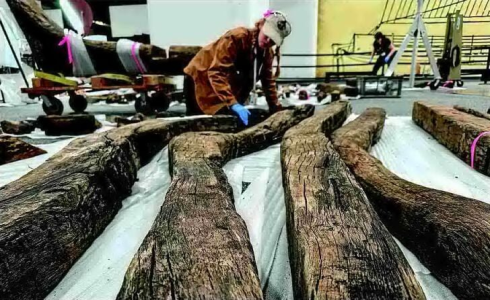- Joined
- Mar 11, 2020
- Messages
- 209
- Points
- 143


ALBANY, N.Y. — Workers digging at Manhattan's World Trade Center site 15 years ago made an improbable discovery: sodden timbers from a boat built during the Revolutionary War that was buried more than two centuries earlier.
Now, more than 600 pieces from the 50-foot vessel are being painstakingly put back together at the New York State Museum. After years on the water and centuries underground, the boat will become a museum exhibit.
With pieces arrayed like a giant puzzle on the museum floor, research assistants and volunteers recently spent weeks cleaning the timbers with picks and brushes before reconstruction could even begin.
Though researchers believe the ship was a gunboat built in 1775 to defend Philadelphia, they still don't know all the places it traveled to or why it ended up apparently neglected along the Manhattan shore before ending up in a landfill around the 1790s.
"The public can come and contemplate the mysteries around this ship," said Michael Lucas, the museum's curator of historical archaeology. "Because like anything from the past, we have pieces of information. We don't have the whole story."
The rebuilding caps years of rescue and preservation work that began in July 2010 when a section of the boat was found 22 feet below street level. Curved timbers from the hull were discovered by a crew working on an underground parking facility at the World Trade Center site, near where the Twin Towers stood before the Sept. 11, 2001, terrorist attacks.
The wood was muddy but well preserved after centuries in the oxygen-poor earth. A previously constructed slurry wall went right through the boat, though timbers comprising about 30 feet of its rear and middle sections were carefully recovered. Part of the bow was recovered the next summer on the other side of the subterranean wall.
The timbers were shipped more than 1,400 miles to Texas A&M's Center for Maritime Archaeology and Conservation.
Each of the 600 pieces underwent a three-dimensional scan and spent years in preservative fluids before being placed in a giant freezedryer to remove moisture. Then they were wrapped in more than a mile of foam and shipped to the state museum in Albany.
While the museum is 130 miles up the Hudson River from lower Manhattan, it boasts enough space to display the ship. The reconstruction work is being done in an exhibition space, so visitors can watch the weathered wooden skeleton slowly take the form of a partially reconstructed boat.
Work is expected to finish toward the end of the month, said Peter Fix, an associate research scientist at the Center for Maritime Archaeology and Conservation who is overseeing the rebuilding. On a recent day, Lucas took time to talk to museum visitors about the vessel and how it was found. Explaining the work taking place behind him, he told one group: "Who would have thought in a million years, 'someday, this is going to be in a museum?'"
Analysis of the timbers showed they came from trees cut down in the Philadelphia area in the early 1770s, pointing to the ship being built near the city. It was probably built hastily. The wood is knotty, and timbers were fastened with iron spikes. That allowed for faster construction, though the metal corrodes over time in seawater.
Researchers now hypothesize the boat was built in Philadelphia in the summer of 1775, months after the first shots of the Revolutionary War were fired at Lexington and Concord in Massachusetts. Thirteen gunboats were built that summer to protect Philadelphia from potential hostile forces coming up the Delaware River. The gunboats featured cannons pointing from their bows and could carry 30 or more men.
Historical records indicate at least one of those 13 gunboats later was taken by the British. There is some evidence that the boat being restored was used by the British, including a pewter button with "52" inscribed on it. That likely came from the uniform of a soldier with the British Army's 52nd Regiment of Foot, which was active in the war.
It's also possible that the vessel headed south to the Caribbean, where the British redirected thousands of troops during the war. Its timbers show signs of damage from mollusks known as shipworms, which are native to warmer waters.
Still, it's unclear how the boat ended up in Manhattan and why it apparently spent years partially in the water along shore.
By the 1790s, it was out of commission and then covered over as part of a project to expand Manhattan farther out into the Hudson River. By that time, the mast and other parts of the Revolutionary War ship apparently were stripped. It's an important piece of history," Lucas said. "It's also a nice artifact that you can really build a lot of stories around."
Marcus



